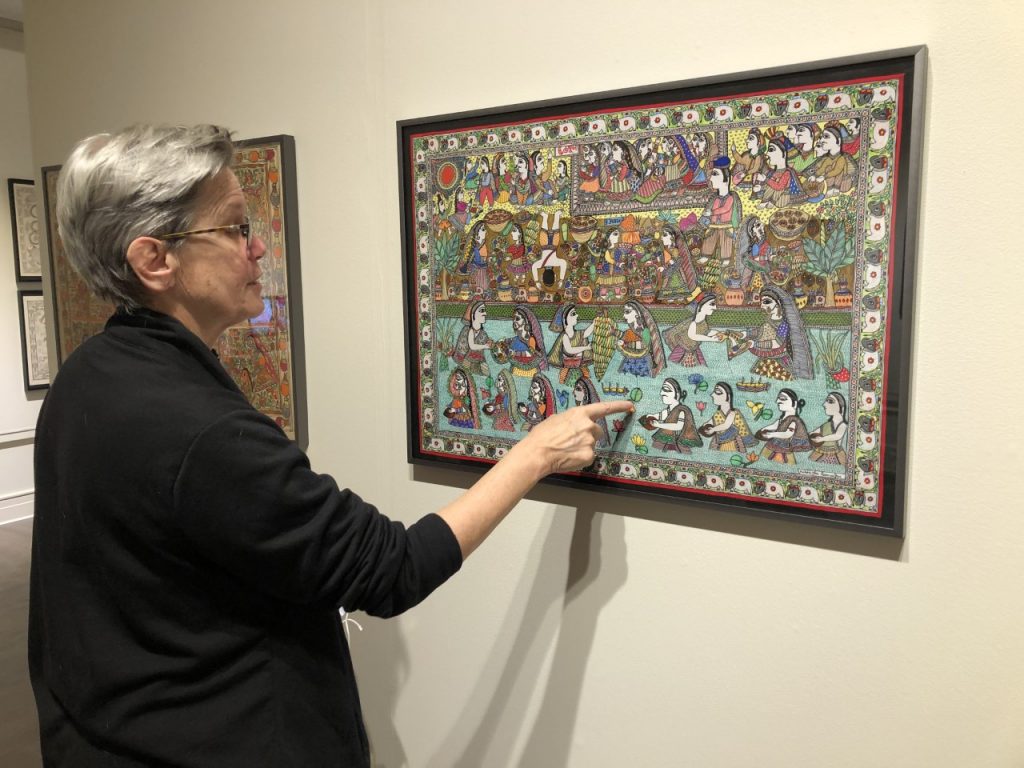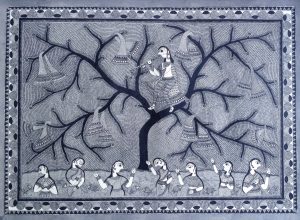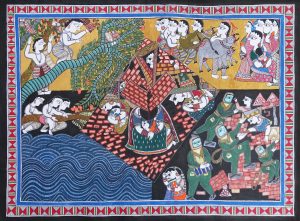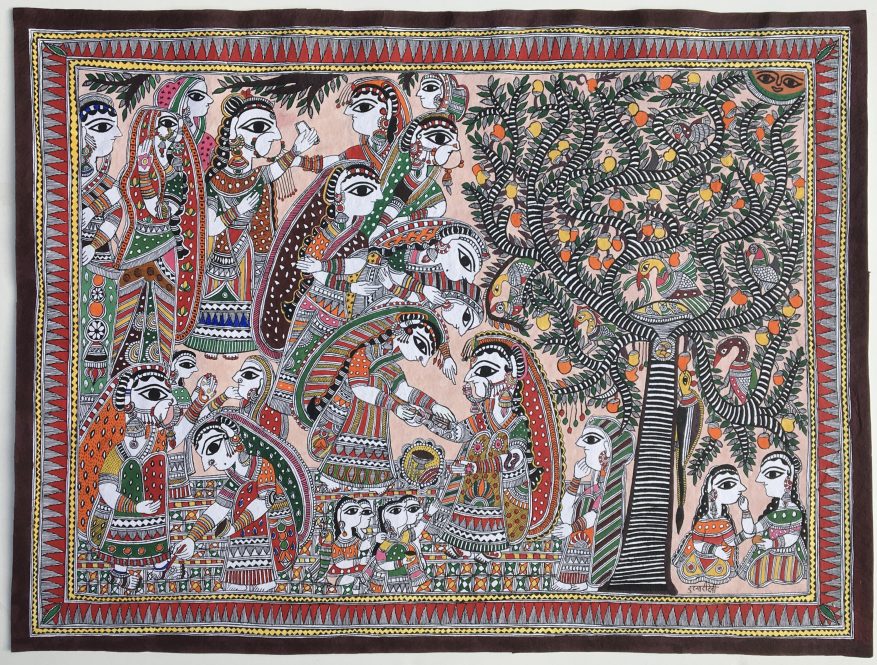Kathryn Myers has made nearly two dozen trips over as many years to India, where her heart found Mithila art by accident in 1999, and where she found a second home when she wasn’t necessarily looking for one.
“When I first went to India, I was already 40 and you think you’re old and you don’t think anything new is coming,” the painting professor in the School of Fine Arts says. “You’re doing the same thing and there’s a nice sense of stability. But when I went into the Handicrafts and Handloom Museum in New Delhi and saw Mithila and other forms of indigenous and tribal art, I felt like I was going to pass out I was so affected by this work.”

She bought her first pieces at a craft fair where standard depictions of Hindu gods and goddesses were primarily marketed for tourists. Through the years her collection grew, and Myers says she just couldn’t satisfy the desire to see more.
She came home from that first trip and studied the three major styles of Mithila art and learned the stories of deities, as well as the different castes in Hindu culture that determine some of the style differentiations of Mithila art. Later, she returned to India to the small town of Madhubani to watch the artists’ freehand technique of drawing with ink on paper and their process of starting with the creation of a border and working inward to the center.
She created the UConn class “Indian Art and Popular Culture: Independence to the Present” from scratch in 2005 and curated two shows in 2004 and 2013 at the William Benton Museum of Art centering on Indian art.
Her third, “Tradition and Transformation: Mithila Art of India,” puts her collection of now 40 pieces of Mithila art on display at the Benton until July 31.
No one knows just how long Mithila art has been around, Myers explains, but most conjecture states at least 700 years. It originates in a part of India that’s remote – five hours outside the nearest city in the northeastern part of the country and in villages dotted with thatched huts and cinder block structures. There, women paint Mithila murals on the walls of their homes to celebrate weddings and other events.
British colonial officer William Archer is generally credited with bringing a greater awareness of Mithila art to the mainstream, after he was in the area on a humanitarian mission following an earthquake in 1934 and found the murals in the rubble of homes, she says. Years later, with the help of Indian crafts agencies and non-governmental organizations, Mithila artists were encouraged to create works on paper to sell in tourist markets to both earn a living and preserve the tradition.
“No one outside the immediate area had ever seen this artwork before,” Myers says of Archer’s discovery. “It was described as hidden from history.”
Today, as well as continuing to depict images of Hindu deities, many Mithila artists also draw from current events.

In the Benton exhibit, visitors can see the painting “9-11” by Leela Devi, which depicts the twin towers and two airplanes, along with “Responsibilities of Women During Covid” by Vinita Jha and her characters in masks performing chores around the home.
But there are plenty of traditional paintings of agrarian life in the exhibit, with fish and trees and plants, as Myers says many of the artists have become adept at fluctuating between the styles once defined by caste and traditional and contemporary subjects.
“The Poor Girl and the Squirrel” by Arti Kumari tells the story of a young girl who falls in love with and marries a squirrel. People ridicule her for the act, Myers says, the squirrel is killed, and the girl burns herself on the funeral pyre, in a now outlawed practice called sati during which a widow would burn herself to ash on her husband’s funeral pyre.
“These are the traditions of certain places, and the art reflects that,” Myers says.
She says she’s fond of the Dulari Devi painting, “Krishna Stealing the Saris of the Gopis,” which shows the god Krishna playing his flute and entrancing the Gopis who are falling in love despite his adolescent prank of taking their clothes.
What’s unusual in this work, Myers says, is that while in other painting traditions the women are often depicted nude — in various states of contortion as they try to cover their bodies — in these images only the women’s legs are bare. She suggests that’s because Mithila art is so much about obsessively detailed patterns and without clothing there’s nothing on the bare skin to pattern.
“These themes have been painted over and over again by artists,” she says. “That always impresses me, that you can take an old theme or a deity that’s been painted thousands of times and find something new in it, find something to make it fresh.”
There are at least four paintings in the Benton exhibit that depict Krishna.
She also likes Dulari Devi’s “Marriage Preparations” and the way it shows all of the ceremonies leading up to a wedding from henna tattoos to feasting: “I just love the denseness and the joyfulness of it.”
The Benton exhibit, which was postponed in the pandemic, benefitted from the delay, Myers says.
Originally, she planned to showcase a variety of indigenous art, in addition to her personal collection of about 20 Mithila pieces. But that changed when David Szanton from the Ethnic Arts Foundation approached her to offer an additional 20. The organization is closing after 42 years and is disbursing its collection to artists, historians, and curators with the caveat that it be publicly available.

Myers says that after the Benton exhibit, she plans to take part of the collection to the Floyd Art Center in Virginia for a co-curated exhibition on Mithila art and then back to Connecticut where it’ll be on display in 2023 at UConn Avery Point.
But this may be the last show for Myers at the Benton.
After three Fulbright Fellowships to India in 2002, 2011, and 2020 and a video cataloging project including interviews with contemporary Mithila artists, Myers says she’s looking to retire at some point in the next two years and jokes that she’ll get a camper and take the show on the road.
What is certain is she plans to return to India next winter, to the place that changed the course of her academic research and the direction of her own art.
That first trip to India for an artist residency in 1999 turned her from the work she had been doing on life-sized baroque imagery with a contemporary touch to small-scale watercolors of Indian architecture.
She says she “was just so stimulated by the environment that I started making paintings of what I saw. It used to be figures and spaces, but then after awhile I realized I was like an outsider looking at Indians and their spaces.
“Over the years I’ve spent so much time there I thought, ‘It’s my place, too,’” she continues, “so the figures disappeared, and it became about space and architecture and these interesting arrangements of buildings around me in my world.”
There will be three April events in conjunction with “Tradition and Transformation: Mithila Art of India.” A panel discussion, “Tradition & Transformation In Indigenous Arts of South Asia,” will be held at 3:30 p.m. Wednesday, April 6, at the museum; an interactive workshop, “The Magic of Mithila Art,” will be held at 6:30 p.m. Tuesday, April 12, via Zoom; and a discussion about art, “Changing Times, Changing Art: A Conversation,” will be held at 3:30 p.m. Wednesday, April 13, in the Art Building.



